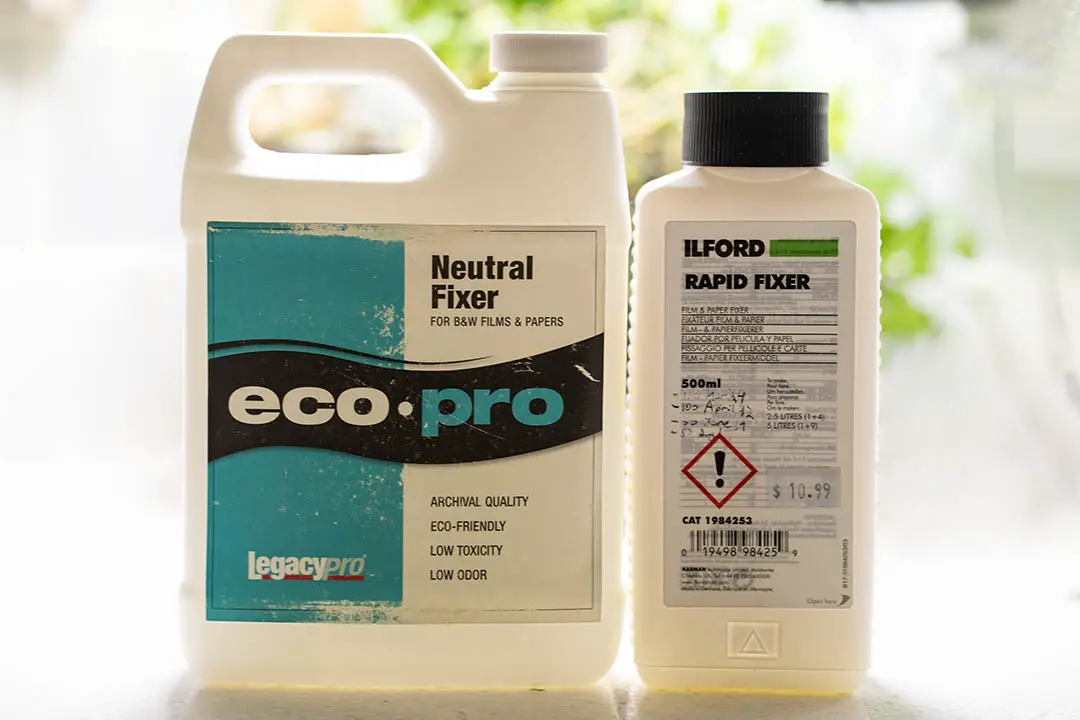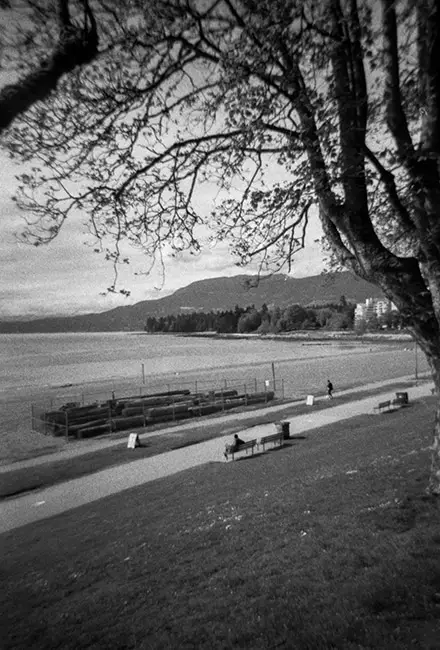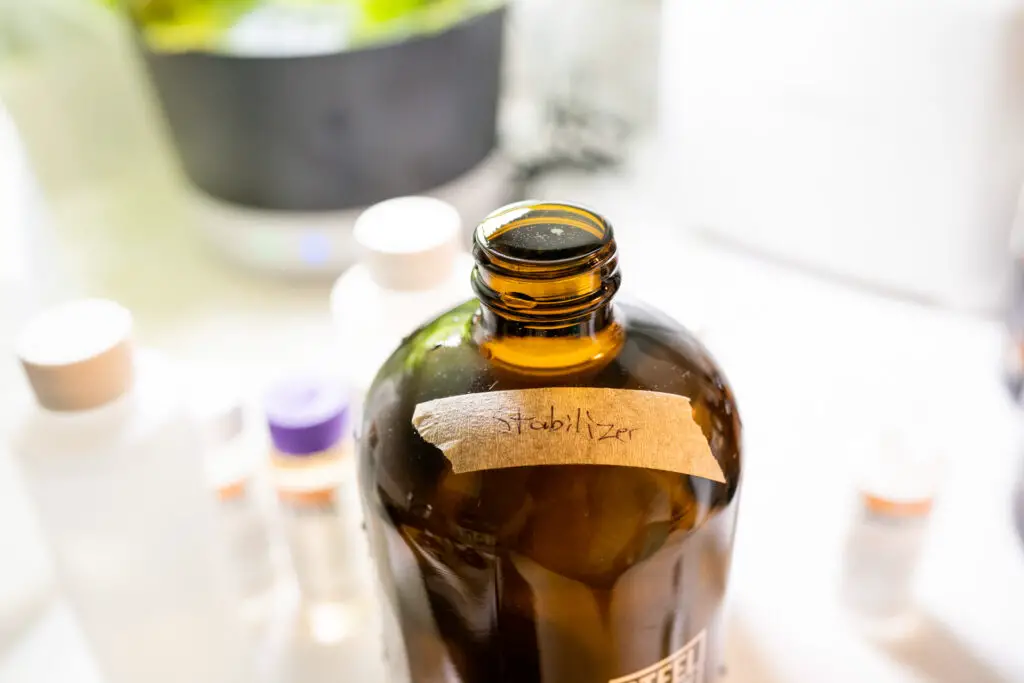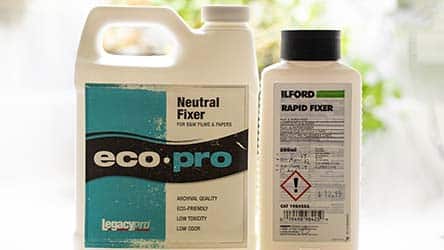It’s a shame that not all film development chemicals can last as long as Rodinal. Film photography has been around longer than the lightbulb, yet we haven’t been able to find a simple solution for chemical breakdown in the presence of oxygen. Both Kodak and Ilford’s Rapid Fixers are those chemicals that just don’t hold up in the presence of air. So how long should you expect a bottle of Kodak or Ilford fixer to last?
As a general rule, an unopened bottle of fixer concentrate will last 2-3 years, and up to 6 months after opening. To extend the life of fixer for a year or longer after opening the bottle, pour the solution into smaller sealed bottles or plastic pouches.
A single liter of Ilford Rapid Fixer or Eco-Pro Neutral fixer can be reused to fix up to 120 rolls of film. For the average film photographer, 6 months just isn’t enough time to get the full use out of a bottle. So it’s always worthwhile to purchase a couple of smaller bottles with good seals to reuse the fixer as much as possible.
My personal favorite bottles to store fixer stock solutions in come from local breweries. They’re air-tight when full, and come with beer for the same price as buying from suppliers. These bottles all come with different designs, so they’re easy to distinguish from each other (although I still recommend labelling everything).
But if you’re going through a liter or less fixer in a single year, you will have to store the concentrated fixer in smaller air-tight containers. A half-full bottle of Kodak or Ilford rapid fixer will lose its potency in only 2 months compared to a full bottle’s 6-month shelf life. I’ve had great luck using these storage pouches to keep film chemicals fresh long term. Just make sure to label with a sharpie so you know which chemical is in the bag!
Quick Links:
Fixing Times | When Fixer Goes Bad | Rapid Fixer vs. Neutral Fixer | How to Store Fixer

How long should I fix my film?
One of the most common questions related to fixing film is how long it takes to completely fix a roll. According to the technical data sheets of Kodak Rapid Fixer, Ilford Rapid Fixer, and Eco-Pro Neutral fixer, all films require the same amount of time to fix to completion. Here’s what we found:
Most black and white films will be completely fixed within 2-5 minutes in a fresh fixer solution. T-Grain films, like Kodak TMax or Ilford Delta films, need 3-5 minutes. Fixing times will increase when reusing the fixer because excess silver in the solution slows down fixer activity.
Over time, it’s a good idea to lengthen the amount of time for fixing from 5 minutes to as long as 8 minutes to ensure your negatives are completely fixed.
Be sure to properly wash your film after the fixing step, as the fixer can cause damage to the film over the years. Ilford’s technical datasheets describe a washing method that uses the least amount of water possible.
Fill the tank once, and do five inversions, then dump out the water and refill. Do 10 inversions, and then refill the tank once more and do 20 inversions. After dry and store the film in acid-free archival sleeves for long-term storage.
How to tell if you’re fixer has gone bad
After doing a bunch of reading online, I’ve seen people suggest all kinds of fixer tests, including doing a taste test — which should never be done under any circumstances. Luckily, there are other safe ways to make sure your fixer still has enough juice to make your film archival. Here’s what I’ve found.
To test if your fixer is still usable, cut off the leader from a roll of 35mm film, and immerse it in the mixed fixer solution. If the film leader turns transparent within 4 minutes, the fixer is still usable. Or, use hypocheck to test your fixer integrity in seconds.
The film leader test is the cheapest method, so long as your camera doesn’t have an auto-winder that retracts the film all the way back into the canister. If that’s the case, then you’ll need a film retriever to bring out the leader. Or, if you break open the canister to load film onto the reels, there is always an extra bit of unused film in the 35mm canister that is perfect for the fixer test.
Medium and Large Format only photographers will need to use a hypocheck solution to check fixer integrity since the clearing test can’t be done without destroying an expensive roll or sheet.
Using hypocheck is simple. Just put a drop into the fixer solution, and if nothing happens, the fixer is still good. If a cloudy precipitate forms, then it’s time to make a new batch.

What happens if the film is fixed in a bad solution?
We’ve all had rolls come out that look just a little strange and wonder if it’s because of the fixer or the developer going bad. It does happen to everyone at least once. For me, it’s happened a couple times near the end of the fixer’s life where I’ve become impatient and stop fixing at the 5 minute mark instead of letting it go on a little longer for safety. And when the film comes out, it looks good. Then, if I leave it hanging to dry in a sunny window, it starts producing a noticeable fog.
Insufficiently-fixed film will have a cloudy or milky appearance, either immediately after pulling it out of the tank, or over a couple days. If your film starts to appear milky, simply re-fix the film in a fresh fixer. Most times this will completely clear the negatives.
The good news is under fixing is rarely unrecoverable. If you come back twenty or thirty years later though, chances are simply dumping it in a fixer solution won’t solve your issue. But it’s always worth a shot.
Why does fixer degrade in oxygen?
The reason fixer breaks down in the air is because it’s a reducing agent. For non-chemistry nerds, that means they readily interact with oxygen ions in the air.
So it’s easy to see how they can break down in open bottles. But they’re also only viable for 2 years in a sealed bottle. That’s because small amounts of oxygen are able to break through the relatively porous plastic bottles they’re shipped in. Even though these bottles are sturdy and relatively thick, there are always going to be microscopic holes that are just big enough for air to get through with enough time.
Can I mix fixer with tap water?
When using fixer with no plans of storing the diluted solution long term, it’ll be okay to mix it with tap water. But
In some places, tap water contains dissolved minerals that will react with the fixer and reduce its efficacy over time. Using distilled water, and sealing the bottle without air will ensure that 1L of diluted fixer remains viable for up to 6 months.
Rapid Fixer Vs. Neutral Fixer Shelf Life
Neutral fixer is perfect for people who have eczema or are sensitive to that pungent fixer odor. I’ve been using the neutral fixer and gloves for the past year and have noticed a major difference in my skin. But the other benefit of neutral fixer is that it doesn’t require an acid stop bath, and it lasts longer than Ilford or Kodak’s rapid fixers. Where a regular rapid fixer only lasts 6 months after it’s opened, a bottle of neutral fixer can last an entire year.
That said, most solutions can last longer if they’re stored correctly. The best solution is to always fill sealable glass bottles all the way to the top so that no air can get in. If you’re able to do that, then the solutions will last long enough to use them up completely.

How to store opened bottles of fixer
Fixer should always be stored in cool, light-free conditions according to Ilford and Eco-Pro technical datasheets. These solutions are able to tolerate some exposure to air, but they will degrade faster as the bottle is emptied.
That means storing the opened fixer into smaller bottles, or in plastic containers that you can squeeze the air out of will make unused fixer last longer.
One piece of advice I have is to not use metal lids when storing Rapid Fixer. I suggested above the use of growler bottles, and I’ve had good success with them when using the plastic lids. Fixer is designed to remove the still light-sensitive silver ions on the film, meaning that they react with metals. Well, if there’s metal in the lid of your bottle, the fixer will also react with that. I’ve come back to a diluted fixer solution stored in one of these after six months sitting under the sink, only to find that there was a hole in the top of the lid.
It’s one of those experiences that you never expect to have, but can only laugh about when you do. In hindsight, it makes sense that the fixer could eat away the metal lid, but it’s just not something I ever imaged.
So the best way to keep these chemicals fresh and lasting a long time, is to store the stock solution in smaller, fully-filled sealed bottles. After mixing the solution to a 1+4 for film or 1+9 solution for prints, keep the bottles as full as possible in well-sealed bottles. Preferably glass with plastic lids, although the plastic storage bottles will work as well — albeit not as long since they are more porous.
Using these techniques, you should easily be able to keep a bottle of fixer lasting for well more than a year at a time. Have you ever gotten the maximum capacity out of a bottle of fixer? If so, I’d love to hear about it in the comments! Let me know below how you keep your fixer solutions.

By Daren
Daren is a journalist and wedding photographer based in Vancouver, B.C. He’s been taking personal and professional photos on film since 2017 and began developing and printing his own photos after wanting more control than what local labs could offer. Discover his newest publications at Soft Grain Books, or check out the print shop.

